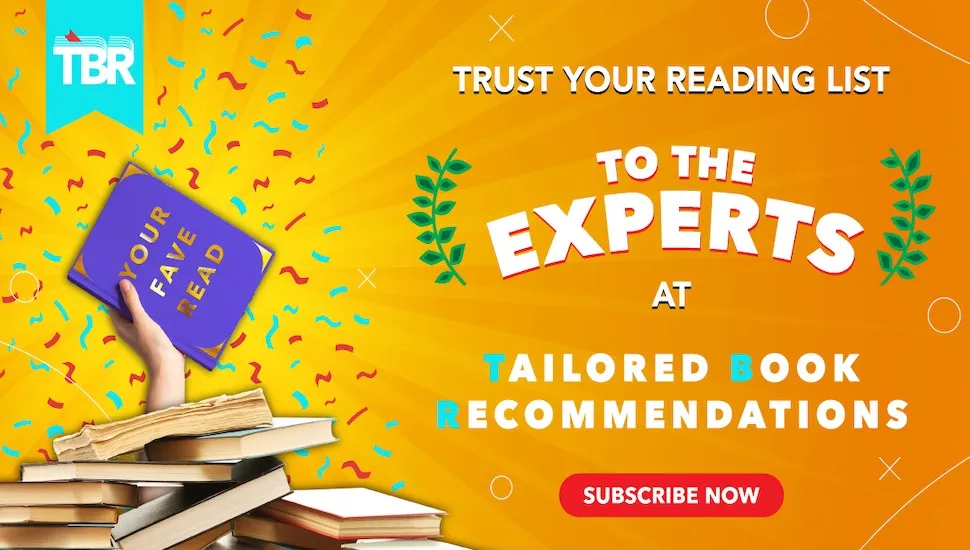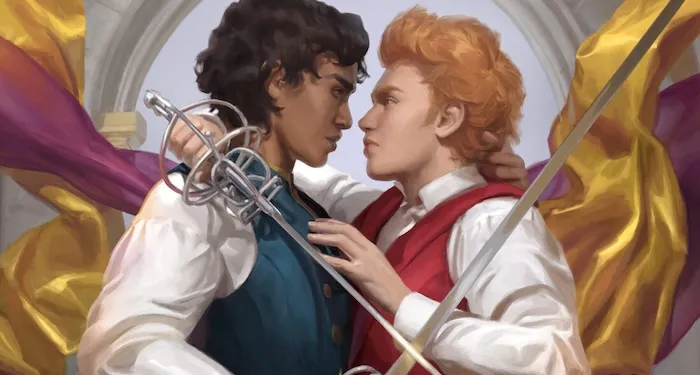
8 of the Best New M/M Romantasy Books
Romantasy, a portmanteau of romance and fantasy, has grown in popularity over the last two years. Books in this subgenre typically feature straight couples, with an emphasis on heteronormative relationship styles. But despite the subgenre’s enormous success in the publishing landscape, there appears to be a lack of representation for LGBTQ folks.
Why are there so few romantasy books featuring gay relationships, particularly between two men?
“I believe there’s two reasons for this. The first being book bans. Book bans are keeping bookstores from acquiring LGBTQIA+ books. This leads to the second reason: publishers not wanting to take the risk. If bookstores, especially big box stores, aren’t acquiring LGBTQIA+ books, then publishers are fearful to acquire LGBTQIA+ books even though there is a market for it,” says romantasy author SE Berkeley.
For writer Joshua Lisec, it’s a supply and demand situation, which aligns with Berkeley’s viewpoint. “The majority of romantasy readers are heterosexual women… When publishers take risks on gay stories, they tend not to sell as well because there is little demand, even if it is critically acclaimed.” He also explains that for literary agents, acquiring LGBTQ-focused stories may appear to be a “labor of love” or a “political signaling” rather than a commercial success strategy.
The lack of enough M/M romantasy almost always extends to other LGBTQ identities, particularly sapphic. There’s also a small market for romantasy featuring queer women. Some sapphic books in other genres may have gained traction, but not in the same way that M/F romantasy or M/F-focused books in general have. This definitely merits a similar list, but that’s for another day.
For now, I listed a few M/M romantasy recommendations if you’re looking for one. Take note, however, that the community doesn’t appear to agree on what exactly constitutes “romantasy” — should the story focus more on the romance or the fantasy? What about both? So, for the sake of simplicity, I put together books that may fall into two categories: “romantic fantasy,” which emphasizes fantasy before romance, and “fantasy romance,” which focuses on the relationship aspect of the story.
In the list, I’ve also included books from danmei fantasy, a genre similar to romantasy but incorporates elements of Chinese mythology. These books seem to be becoming more popular, as shown by the boom of Boys’ Love (or BL) manga and some readers’ growing disinterest in Eurocentric fantasy.
Here are some recently released and forthcoming M/M romantasy books:

The Sun Blessed Prince by Lindsey Byrd (May 6, 2025)
Prince Elician of Soleb is a Giver, or someone who never dies. He has the ability to give life or heal wounds simply by touching someone. He and his friend Lio are sent to the battlefield to fight the rival kingdom’s army, Alelune, for authority over a sacred river. When assassin and Alelune agent Cat attempts to kill Elician, he’s unable to do so. Except for Elician, Cat is a Reaper who can kill anyone by simply touching them.
Instead of punishing Cat, however, Elician sends him to a group of Reapers to investigate his intentions. During the trip there, they develop a slow-burning romance. When Elician and Lio return to the war, they are taken by Alelune soldiers. Cat, who has grown close to Elician’s family, must figure out his whereabouts.
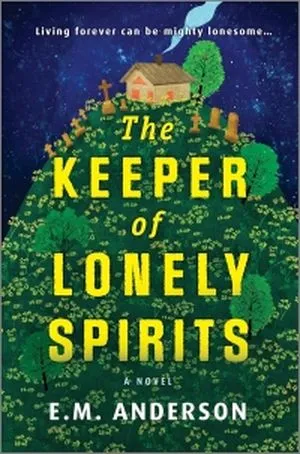
The Keeper of Lonely Spirits by E.M. Anderson
This is somewhat rare because M/M romantasy that involve men in their old age are few and far between.
Peter, who sees ghosts, is cursed to live forever. He also feels lonely; everyone he loved died a long time ago, yet he still lives. When he moves to Ohio to search for a vengeful spirit, he meets historian David. The two strike up a heartfelt romance, and Peter finds his newfound family in the community.
But Peter worries that David and his friends will die soon, leaving him all alone once again. Despite his genuine feelings for David, Peter is hesitant to commit.

Celestial Monsters by Aiden Thomas
Celestial Monsters is the second installment of Thomas’s Sunbearer Duology. In the first book, teenagers compete in a The Hunger Games-like trial orchestrated by a god, and the winners and losers fight to protect the place known as Reino del Sol. Teo, the story’s main protagonist, soon begins a slow-burning romance with Aurelio, a competitor in the games.
In the second book, the romance between the characters becomes more apparent. Meanwhile, Reino del Sol is plunged into darkness as the Obisidian gods, the story’s villains, are unleashed. Now, it’s up to Teo, Aurelio, and their friend Niya to save the world and restore light on Reino del Sol.

The Emperor and the Endless Palace by Justinian Huang
This one draws inspiration from Buddhist ideals, specifically the theory of reincarnation.
The story follows two men who are reincarnated multiple times throughout history. First, in 4BCE, a ruler and a courtier experience a strong attraction to each other. In 1740, an innkeeper assists a mysterious stranger. Then, in present-day Los Angeles, a student experiences an odd sense of déjà vu when they encounter someone.
The plot doesn’t follow traditional storytelling conventions, but it will appeal to readers of romance, fantasy, and even erotica.
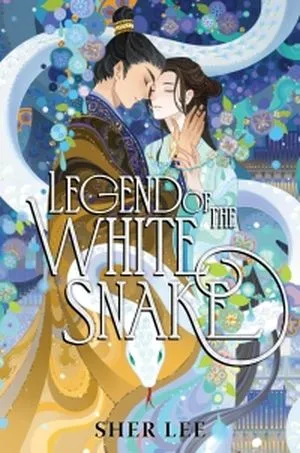
Legend of the White Snake by Sher Lee
This is loosely based on the Chinese myth “Legend of the White Snake.”
Prince Xian’s mother is bitten by a snake and is slowly dying. The only way to save her is to track down a white snake who has a coveted spirit pearl. So Xian heads to Changle in search of one.
Enter Zhen, a white snake who swallowed a spirit pearl seven years ago and can now transform into a human. In Changle, they meet and are instantly attracted to each other. Zhen, however, quickly realizes that he’s the white snake Xian is looking for.
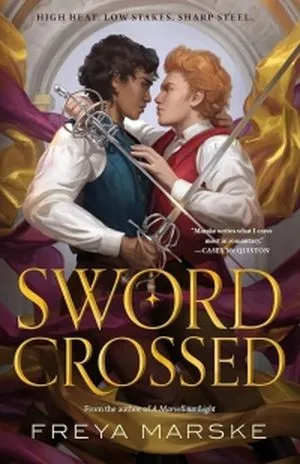
Swordcrossed by Freya Marske
Matti, who is the heir to his family’s business, is planning his wedding. He requires a swordsman as a bestman, and so he hires Luca.
Luca, meanwhile, has recently fled his hometown and hopes to start a new life. As Matti’s wedding date approaches, each of the men’s problems unravels, but they gradually develop a romance. Luca’s secrets, however, serve as a hurdle to their growing intimacy.

Sorcery and Small Magics by Maiga Doocy
This is a romantasy with an enemies-to-lovers trope.
Leo can perform minor magic, but anything more serious will land him in trouble. Unfortunately, a spell binds him to his enemy, Sebastian, and he has no choice but to obey his command. Sebastian is well-regarded in their community, whereas Leo has a bad reputation.
When a powerful sorcerer begins to cause havoc, the two are forced to enter the Unquiet Wood to undo a curse—and work together to understand Leo’s magic, all while navigating a chaotic romance.

Legend of Exorcism: Tianbao Fuyao Lu (Novel) Vol. 1 by Fei Tian Ye Xiang
Hailing from the Taihang Mountains, Hongjun is sent on a dangerous mission to conceal his true identity and join a group involved in demonic exorcisms in Chang’an.
There, he meets Li, a common soldier who leads an exorcist team. Hongjun, Li, and their companions must stop the evil from destroying the city. At the same time, a romance develops between the two, but can Hongjun trust Li with his secret?
Looking for more LGBTQ romantasy books than just MM romance? There are books about sapphic relationships and other LGBTQ identities.
The following bonus content comes to you from the Editorial Desk. Enjoy this sneak peek!
This week, we’re highlighting a post that celebrates the 100th anniversary of The Great Gatsby! Revisit F. Scott Fitzgerald’s classic (and emblem of assigned reading) and get a crash course on the book’s history, including challenges encountered by its readers and adapters. Read on for an excerpt and become an All Access member to unlock the full post.
January 16, 2025, marked the 100th anniversary of the publication of F. Scott Fitzgerald’s novel The Great Gatsby. The New York Public Library celebrated with a party, following a special performance of the Broadway musical adaptation of the novel. Simon and Schuster recently released a new audiobook with an introduction by Jesmyn Ward.
The novel’s theme of reinventing oneself is timeless. The ideas of living a lie by reinventing yourself and wealth making people callous are equally resonant today. How did this novel become so influential, especially on other American novels, and a fixture on high school syllabi? Was it always a bestseller? What aspects of Gatsby hold up, and which ones have aged terribly?
Fitzgerald’s original title for The Great Gatsby was Trimalchio in West Egg. I think the publisher was right to change it. Trimalchio is a character from the ancient Roman work The Satyricon. Combined with the fictional West Egg neighborhood, this reference is cryptic. Gatsby is now an icon in his own right. He doesn’t need a classical allusion for us to notice the theme of excessive wealth.
In a 2014 NPR interview, Maureen Corrigan, the author of So We Read On: How The Great Gatsby Came to Be and Why It Endures, explained how Gatsby became popular. Initial reception was mixed, ranging from the headline “Fitzgerald’s Latest a Dud,” to Modernist poets like T. S. Eliot saying they loved it. When Fitzgerald died in 1940, Gatsby was unpopular (but not out of print). A few years later, it was republished for US service members in World War II, and 123,000 copies were given to members of the military through the Armed Services Editions.
After World War II, Gatsby was no longer an obscure book with mixed reviews. It was considered a classic and became a staple of countless high school syllabi. Constance Grady wrote that Gatsby was ideal for many 20th and early 21st-century English teachers’ emphasis on New Criticism. It’s a great choice for close readings of short passages and analyzing symbolism. However, historical context is also crucial and should never be downplayed, especially in terms of bias.
The Great Gatsby possibly condemns white supremacist theories but uses racist language elsewhere. Tom Buchanan reads white supremacist books and goes on racist rants. Daisy mocks him for this. It’s easy to read this as condemning Tom’s overall bigotry. However, Fitzgerald also expressed racist and antisemitic views in real life.
Sign up to become an All Access member for only $6/month and then click here to read the full, unlocked article. Level up your reading life with All Access membership and explore a full library of exclusive bonus content, including must-reads, deep dives, and reading challenge recommendations.
